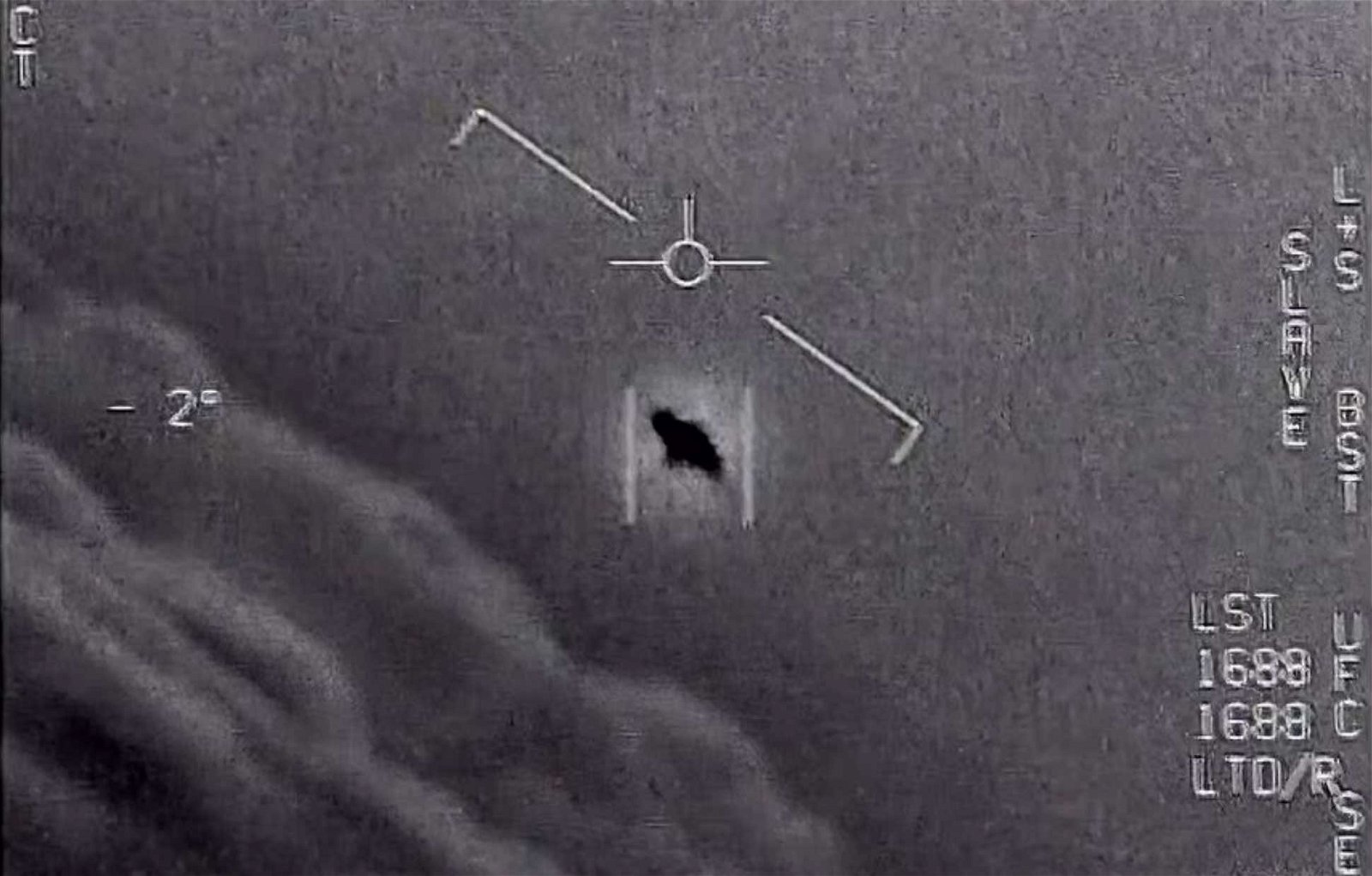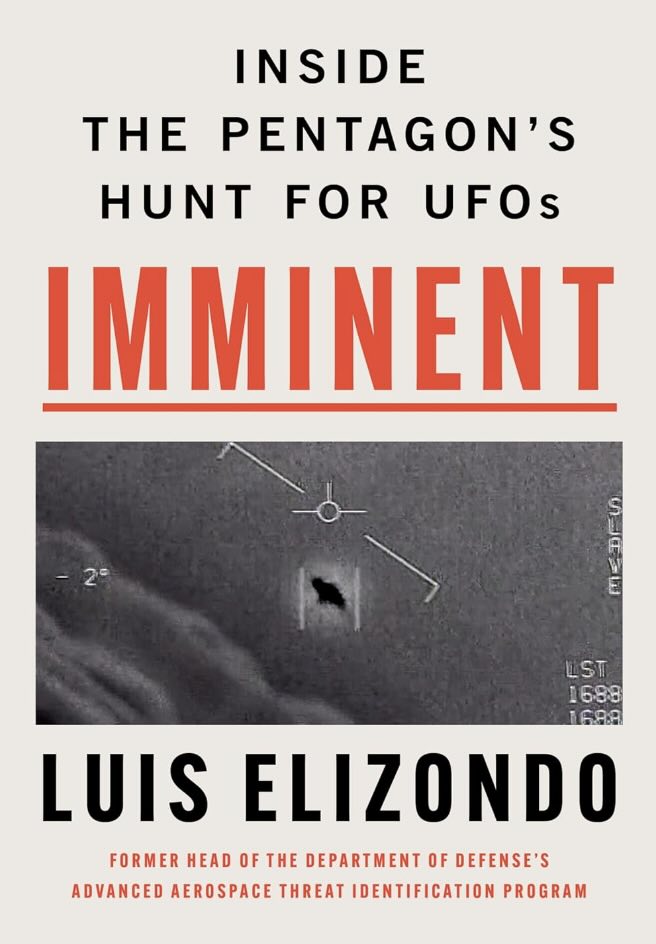

Welcome to this week’s installment of The Intelligence Brief… this week, a new memoir by former U.S. counterintelligence agent Luis Elizondo was officially released, and in our analysis, we’ll be looking at 1) the release of Elizondo’s Imminent: Inside the Pentagon’s Hunt for UFOs, 2) what Elizondo has said publicly about his past government work since the book was released, and 3) why issues involving U.S. government transparency remain at the forefront of the public UAP debate.
Quote of the Week
“I believe that the American people have a right to know about the presence of UAPs in our skies.”
– Luis Elizondo
Latest News: In recent articles at The Debrief, researchers have found something hidden in many libraries that could potentially poison you. Elsewhere, NASA citizen scientists have made the remarkable discovery of an unknown object traveling through space at more than 1 million miles per hour. You’ll find links to all our recent stories at the end of this week’s newsletter.
Podcasts: In podcasts this week, over on The Micah Hanks Program we are joined by Professor Michael Bohlander, the Chair in Global Law and SETI Policy in the Durham Law School, and Dr. John Elliott, Coordinator for the SETI Post Detection Hub at the University of St Andrews to discuss how international laws could apply if contact with ET ever occurs. Meanwhile, in advance of the return of The Debrief Weekly Report from its summer break, you can catch up on past episodes over on The Debrief’s Podcasts Page.
Video News: On the latest episode of Rebelliously Curious, Chrissy Newton is joined by Kimberly Engels for a discussion of how “human sensors” can apply to modern UFO research. Be sure to check out other great content from The Debrief on our official YouTube Channel.
With all that behind us, it’s time to look at the latest regarding Luis Elizondo, a famous whistleblower whose widely anticipated new book addresses issues related to government secrecy regarding UFOs.
Inside the Pentagon’s Hunt for UFOs
This week, a long-awaited new memoir detailing an insider’s view of official U.S. government investigations into UFOs finally made its way onto shelves.
Imminent: Inside the Pentagon’s Hunt for UFOs details official investigations into what the U.S. military now calls unidentified anomalous phenomena (UAP), according to Luis Elizondo, a former U.S. Army Counterintelligence Special Agent and former employee of the Office of the Under Secretary of Defense for Intelligence.


Elizondo first made headlines in late 2017, when the New York Times, Washington Post, and Politico revealed in near-simultaneous reporting that he had led a limited effort to study UAP from within the government. Elizondo officially resigned from his position only weeks before going public, citing a lack of progress in addressing potential threats associated with aerial phenomena among his reasons.
Now, the release of Imminent marks the latest stage in Elizondo’s post-government efforts to bring awareness to the UAP situation after becoming a media personality for his public advocacy for greater U.S. government transparency on the issue in recent years.
An Insider’s View on UAP
In an OpEd that appeared in Newsweek on Tuesday, Elizondo expounded on his journey spanning the last several years, which brought him from a science-focused background to becoming deeply involved in investigating UAP.
Although Elizondo says he was initially uninterested in aerial phenomena, the counterintelligence officer’s career, which brought him into U.S. government projects that involved advanced aerospace technology, among other things, eventually led him to the Advanced Aerospace Threat Identification Program, or AATIP. He characterized it on Tuesday as “a niche program” that fell under the Advanced Aerospace Weapons Systems Application Program (AAWSAP), which ran out of the Defense Intelligence Agency (DIA).


During his tenure with AATIP, Elizondo says he and other officials whom he worked alongside examined footage and other data obtained about military UAP encounters. These objects, captured in now-famous videos that accompanied the 2017 story reported by the New York Times and other outlets, seemingly defy the known laws of physics and, according to Elizondo, also raise significant national security concerns.
government Transparency Issues
In his OpEd on Tuesday and his new memoir, Elizondo argues that the U.S. government’s reluctance to publicly acknowledge UAPs is partially due to their lack of solutions for the problem. Nonetheless, he believes the American public has a right to know about these phenomena, and to a greater extent than what has presently been acknowledged.
The appearance of Imminent marks not only the official release of Elizondo’s long-awaited personal recollections about his time in government, but also presents a significant shift away from past assertions about his specific role in that capacity.
Notably, Elizondo refers to himself in Imminent and other recent public statements as having played a significant role in the government’s UAP investigations, “eventually becoming one of its key members,” as noted in his Newsweek piece on Tuesday. When he initially came forward in 2017, the New York Times reported that the AATIP program “was run by a military intelligence official, Luis Elizondo, on the fifth floor of the Pentagon’s C Ring, deep within the building’s maze.” Mr. Elizondo makes no specific references to directing the program in Imminent, further stating on Tuesday that others in the program that he worked alongside “were my equals.”
Elizondo also refers to the AATIP program in Imminent as having been contained within the parent AAWSAP program, which officially ran out of the Defense Intelligence Agency prior to 2012. According to James Lackatski, the former Director of AAWSAP, the AATIP name had originally been used as an unclassified nickname for the AAWSAP program. This also remains the Pentagon’s official stance on the issue, as was conveyed in a historical report published by the DoD’s All-domain Anomaly Resolution Office (AARO) earlier this year. At the time of its publication, The Debrief noted that there were also several issues with the AARO historical report, which included several factual inaccuracies.
Prior to Imminent’s official release this week, its publishers inadvertently made a preview of the then-unpublished book available online, resulting in screenshots from passages and other details being shared on social media.
Despite the expected controversy that has ensued since its publication, for Elizondo, the most important issue regarding the U.S. government’s UAP investigations comes down to transparency.
“[W]e should be transparent about the fact that there are things in our airspace that we don’t fully understand,” Elizondo said on Tuesday.
“Ignorance, stigma, and bias are our greatest enemies, not UAPs.”
That concludes this week’s installment of The Intelligence Brief. You can read past editions of The Intelligence Brief at our website, or if you found this installment online, don’t forget to subscribe and get future email editions from us here. Also, if you have a tip or other information you’d like to send along directly to me, you can email me at micah [@] thedebrief [dot] org, or Tweet at me @MicahHanks.


Here are the top stories we’re covering right now…
- Dark Matter “Conspiracy” Unravels as New Research Challenges Long-Held Assumptions
New data is overturning decades of confusion about a potential “conspiracy” between dark matter and stellar matter.
- 50,000-Year-Old Tree Resin Revealing ‘Sophisticated Technological Processes’ Could Rewrite History of Ancient Human Expansion
A 50-thousand-year-old tree resin sample reveals ancient humans colonized the Pacific Ocean thousands of years earlier than previously shown.
- These Electric Bandages Can Heal Wounds 30% Faster Than Normal Varieties, Accelerating Recovery Rates
Researchers have created new water-powered electric bandages that accelerate the healing of chronic wounds.
- Playing Video Games Can Boost Satisfaction and Improve Mental Wellness, New Research Shows
Contradicting previous studies, new research finds that playing video games can improve life satisfaction and mental health.
- Is Dark Matter Made of Primordial Black Holes?
New research is placing dynamical constraints on primordial black holes (PBHs) as a potential dark matter candidate.
- Researchers Discover “Unexpected” New States of Matter in Observations of Odd Electron Phenomena
Unexpected new states of matter that challenge existing theories have been revealed in recent investigations by Georgia researchers.
- NASA’s Cold Atom Lab Aims to Unlock Cosmic Mysteries with Quantum Experiments in Space
The Cold Atom Lab (CAL) is a groundbreaking research setup that introduces a new frontier of quantum science to the International Space Station (ISS).
- Poisons in the Pages? New Research Shows Victorian-Era Books Could Poison Readers
Researchers have found that brightly colored books dating back to the Victorian era could contain poison in their pages.
- NASA Citizen Scientists Spot Unidentified Speeding Object Racing Through Space at 1 Million MPH
NASA citizen scientists make the remarkable discovery of an unknown object traveling through space over 1 million MPH.
- Interstellar Sun-Divers: Probing the Sun’s Corona for Exotic Artifacts
NASA’s Parker Solar Probe and other space observatories could be used to study interstellar “Sun-divers.” What else could they reveal?
- ‘Acid for Squares’ Explores Mind-Expanding Psychedelic Experiences in Groundbreaking New Podcast
Transformative psychedelic experiences, healing through plant medicines, and UFO disclosure are all among the topics that will be explored in ‘Acid for Squares.’
- Hacking Wireless Bicycle Brakes Could be a Big Issue for Races like the Tour de France
Bicycles in races like the Tour de France are using wireless braking systems, making them vulnerable to hacks and other cybersecurity issues.
- Scientists Have Traced Six Meteorites Back to Their Original Craters on Mars in a Scientific First
Scientists have successfully traced six meteorites to their original craters on Mars, providing unprecedented new insights into their origins.
- DARPA-Funded Laser Research Program May Lead to New Atomic Clock Breakthrough
New laser research by the Defense Advanced Research Projects Agency (DARPA) is paving the way toward developing the most accurate atomic clock ever constructed.
- Unraveling ‘Oumuamua’s Anomalous Acceleration: Could This Interstellar Object Have Been Manufactured?
Harvard astronomer Avi Loeb revisits the argument for the interstellar object ‘Oumuamua potentially being technologically manufactured.
- Awesome Super-Sized Nano Transparent Screen Uses Nanoparticles to Adjust to Its Environment
A new 100-inch Nano Transparent Screen (NTS) has been developed that can change its transparency depending on its environment.
- How the Barbie Movie Unexpectedly Spiked Public Interest in Gynecologic Care
Recent research is showing how the Barbie Movie unexpectedly sparked renewed interest in gynecologic care.
- 4 Billion People Lack Access to Clean Water, Concerning New Study Reveals
Half of the planet’s population lacks access to clean water, according to new findings that reveal the impact of poor water quality.
- Alleged Security Breach May Have Exposed 3 Billion People’s Personal Data
Security experts have warned about an alleged breach earlier this year that may have exposed sensitive personal information collected from billions of individuals.
- Sightings: A Status Report
This week on The Micah Hanks Program, we offer a status update from the case files of the UAP Sightings Reporting System (UAPSRS).
- Counterintelligence and the UFO Phenomenon
In an exclusive interview, Joshua Pierson, a seasoned US Army Chief Warrant Officer, delves into the fundamentals of counterintelligence, the importance of structured analytic techniques in understanding UAPs, and the implications for national security.
- 47-Year-Old ‘Wow! Signal’ Mystery Solved? Arecibo Observatory Scientists Think They Have an Answer
Researchers from the famous Arecibo Observatory in Puerto Rico say they may have finally solved the 47-year-old mystery of the ‘Wow! Signal.’
- Google’s DeepMind Has Developed an AI-Driven Robot That Can Beat Humans at Table Tennis
Google’s DeepMind has developed an AI-driven robot that can beat human players in table tennis, marking a significant advancement in robotics
- Addicted to True Crime, Death, and Dark Events? New Research Aims Understand Why.
A new study examines why people love “dark events” and the handful of different social and scientific factors that push us to desire them.
- New Sonic Device Helps Researchers Tackle the Challenge of Measuring Martian Winds
Scientists have developed a novel solution to the long-standing problem of accurately measuring the Martian winds by utilizing sound.
- In the Era of “Fast Fashion,” New Research Reveals the Environmental Toll of Trendiness
New research reveals that “fast fashion” has a waste problem, and it’s outpacing recycling efforts.
- Something Odd is Happening to the World’s Largest Iceberg, and It’s Making Experts Dizzy
The world’s largest iceberg has been engaged in unusual behavior in recent months that has left some glaciologists dizzy.
- 5,000 Years Ago, ‘Advanced Transport Methods’ Were Used to Move Massive Altar Stone at the Center of Stonehenge
New research suggests that the Altar Stone at the Center of the Stonehenge monument likely came from hundreds of kilometers away.
- James Webb Space Telescope Discovers Evidence That Could Finally Resolve Cosmology’s Most Contentious Debate
New data from the James Webb Space Telescope have renewed debate over the Hubble Tension, one of the most controversial issues in astrophysics.
